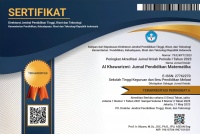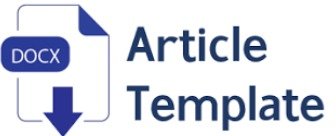Analisis Konseptual Dan Aplikatif Konteks Integral Dalam Kehidupan Sehari-Hari
Abstract
Abstrak: Penelitian ini bertujuan untuk menganalisis konsep integral dalam kalkulus serta penerapannya dalam kehidupan sehari-hari melalui pendekatan tinjauan pustaka kontekstual-tematik. Metode yang digunakan adalah studi literatur yang didasarkan pada berbagai sumber ilmiah relevan, termasuk jurnal nasional dan internasional serta buku ajar kalkulus terapan. Temuan menunjukkan bahwa konsep integral tidak hanya penting dalam konteks akademik, tetapi juga memiliki peran praktis di berbagai bidang seperti transportasi (menghitung jarak dari grafik kecepatan terhadap waktu), ekonomi (akumulasi keuntungan), ilmu lingkungan (mengukur limbah atau polusi), dan kesehatan (menentukan dosis obat berdasarkan laju penyerapan). Kebaruan dari penelitian ini terletak pada pendekatan klasifikasi tematik dan aplikatif yang belum banyak dibahas secara sistematis dalam literatur sebelumnya. Tinjauan ini diharapkan dapat meningkatkan literasi matematis fungsional dan memberikan ilustrasi konkret bahwa konsep integral bersifat kontekstual dan aplikatif dalam kehidupan modern.
References
[1] S. Putranto and G. I. Ratnasari, “Why I Am Confused To Apply Mathematics Concept: Student Perspective of Mathematics Role in Life,” AKSIOMA: Jurnal Program Studi Pendidikan Matematika, vol. 11, no. 1, p. 538, 2022, doi: 10.24127/ajpm.v11i1.4534.
[2] S. Sujatha and K. Vinayakan, “Integrating Math And Real-World Applications?: A Review Of Integrating Math And Real-World Applications?: A Review Of Practical Approaches To Teaching,” no. July 2023, 2024.
[3] Kartimi, A. S. Shidiq, and D. Nasrudin, “The elementary teacher readiness toward stem-based contextual learning in 21st century era,” Elementary Education Online, vol. 20, no. 1, pp. 145–156, 2021, doi: 10.17051/ilkonline.2021.01.019.
[4] M. Zulfitni, D. Ayu, R. Pradita, and C. Author, “Teorema Residu Dan Aplikasinya Dalam Integral,” vol. 11, no. 1, pp. 1–5, 2022.
[5] Y. Suzana, Sabaruddin, S. Maharani, and Z. Abidin, “Mathematics Learning Through Character Education Based on Integrated Thematic Learning: a Development of Learning Materials,” Infinity Journal, vol. 10, no. 2, pp. 301–318, 2021, doi: 10.22460/infinity.v10i2.p301-318.
[6] H. Siswanto, “Mathematical Interpretation of the Geblek Renteng Batik Theme?: Exploring Geometric Transformations,” vol. 4, no. 01, pp. 36–50, doi: 10.56741/jpes.v4i01.664.
[7] T. Aisyah, R. Zannah, E. A.E.L, Y. Trisilaningsih, and N. Y. Priyanti, “Pembelajaran Problem Based Learning,” Incrementapedia: Jurnal Pendidikan Anak Usia Dini, vol. 4, no. 2, pp. 27–36, 2022, doi: 10.36456/incrementapedia.vol4.no2.a6563.
[8] C. Vásquez, J. L. Piñeiro, and I. García-Alonso, “What Challenges Does the 21st Century Impose on the Knowledge of Primary School Teachers Who Teach Mathematics? An Analysis from a Latin American Perspective,” Mathematics, vol. 10, no. 3, 2022, doi: 10.3390/math10030391.
[9] F. D. A. I. G. Wulandari Wangi Ni Kadek, “Jurnal Inovasi Pendidikan,” Jurnall Inovasi Pendidikan, vol. 6, no. 1, pp. 52–61, 2024, [Online]. Available: https://journalpedia.com/1/index.php/jip/article/view/1285
[10] E. A. Abedi, “Tensions between technology integration practices of teachers and ICT in education policy expectations: implications for change in teacher knowledge, beliefs and teaching practices,” Journal of Computers in Education, vol. 11, no. 4, pp. 1215–1234, 2023, doi: 10.1007/s40692-023-00296-6.
[11] S. Livy, T. Muir, N. V. Trakulphadetkrai, and K. Larkin, “Australian primary school teachers’ perceived barriers to and enablers for the integration of children’s literature in mathematics teaching and learning,” Journal of Mathematics Teacher Education, vol. 26, no. 1, pp. 5–26, 2023, doi: 10.1007/s10857-021-09517-0.
[12] M. Naimnule, J. E. Simarmata, and F. Mone, “Penggunaan Teknologi Informasi dalam Pembelajaran Kalkulus I Pada Mahasiswa Program Studi Pendidikan Matematika, Universitas Timor,” Numeracy, vol. 10, no. 1, pp. 33–40, 2023, doi: 10.46244/numeracy.v10i1.1906.
Published
Versions
- 2025-07-31 (2)
- 2025-07-31 (1)
How to Cite
Issue
Section
Citation Check
License
Copyright (c) 2025 AL KHAWARIZMI: Jurnal Pendidikan Matematika

This work is licensed under a Creative Commons Attribution-NonCommercial-ShareAlike 4.0 International License.
Authors who publish with this journal agree to the following terms:
1. Authors retain copyright and grant the journal right of first publication with the work simultaneously licensed under a Creative Commons Attribution License that allows others to share the work with an acknowledgement of the work's authorship and initial publication in this journal.
2. Authors are able to enter into separate, additional contractual arrangements for the non-exclusive distribution of the journal's published version of the work (e.g., post it to an institutional repository or publish it in a book), with an acknowledgement of its initial publication in this journal.
3. Authors are permitted and encouraged to post their work online (e.g., in institutional repositories or on their website) prior to and during the submission process, as it can lead to productive exchanges, as well as earlier and greater citation of published work.






